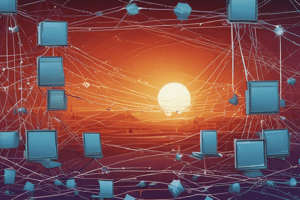Podcast
Questions and Answers
A computer network is a collection of interconnected devices that communicate with each other to share ______ and exchange data.
A computer network is a collection of interconnected devices that communicate with each other to share ______ and exchange data.
resources
A WAN (Wide Area Network) covers a larger ______ area.
A WAN (Wide Area Network) covers a larger ______ area.
geographical
A WLAN (Wireless Local Area Network) is a wireless network that connects devices in a limited ______.
A WLAN (Wireless Local Area Network) is a wireless network that connects devices in a limited ______.
area
The ______ topology refers to the physical layout of devices and connections.
The ______ topology refers to the physical layout of devices and connections.
TCP/IP stands for ______ Control Protocol/Internet Protocol.
TCP/IP stands for ______ Control Protocol/Internet Protocol.
A ______ is a device that connects multiple networks and routes data packets.
A ______ is a device that connects multiple networks and routes data packets.
Flashcards are hidden until you start studying
Study Notes
Computer Networks
Definition
A computer network is a collection of interconnected devices that communicate with each other to share resources and exchange data.
Network Types
- LAN (Local Area Network): Connects devices in a limited geographical area (e.g., home, office building).
- WAN (Wide Area Network): Covers a larger geographical area (e.g., city, country).
- MAN (Metropolitan Area Network): Connects devices in a metropolitan area (e.g., university campus).
- WLAN (Wireless Local Area Network): Wireless network that connects devices in a limited area.
Network Topologies
- Physical Topology: Refers to the physical layout of devices and connections.
- Logical Topology: Refers to the way data is transmitted between devices.
- Common Topologies:
- Bus
- Star
- Ring
- Mesh
Network Protocols
- TCP/IP (Transmission Control Protocol/Internet Protocol): Suite of protocols used for communication on the internet.
- HTTP (Hypertext Transfer Protocol): Protocol for transferring data over the web.
- FTP (File Transfer Protocol): Protocol for transferring files over a network.
Network Devices
- Hub: Simple network device that connects multiple devices.
- Switch: Network device that filters and forwards data packets.
- Router: Device that connects multiple networks and routes data packets.
- Gateway: Device that connects a network to the internet.
Network Security
- Firewall: System that controls incoming and outgoing network traffic.
- Encryption: Process of converting plaintext data into unreadable ciphertext.
- Authentication: Process of verifying the identity of users or devices.
Network Threats
- Malware: Software designed to harm or exploit a network.
- Virus: Type of malware that replicates itself.
- Worm: Type of malware that spreads without user interaction.
- DDoS (Distributed Denial of Service): Attack that overwhelms a network with traffic.
Studying That Suits You
Use AI to generate personalized quizzes and flashcards to suit your learning preferences.




